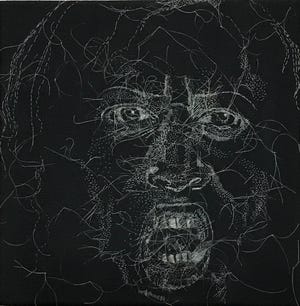Farmington artist opens new exhibition at San Juan College
Rosemary Meza-DesPlas' untraditional style inspires curiosity
- The "Marks, Strokes, and Scribbles" exhibition opens with a reception at 5 p.m. March 6 at the Henderson Fine Arts Center Art Gallery at San Juan College.
- The show remains on display through March 27.
- Rosemary Meza-DesPlas has had her work featured in galleries in Chicago, Paris, South Korea and China.

FARMINGTON — While her work has been featured in galleries not just around the United States but in Europe and Asia, an exhibition by Farmington artist Rosemary Meza-DesPlas opening this weekend will be her first show at San Juan College's Henderson Fine Arts Center Art Gallery.
"Marks, Strokes, and Scribbles: A Survey of Drawings" is a collection of approximately 20 drawings that chronicle Meza-DesPlas' evolution as an artist over the past two decades, a period in which she has worked with her own hair as her primary material. It's a style she developed in fits and starts over a two- or three-year period at the turn of the century.
"It probably took a couple of years to figure it out," she said. "I started by gluing the hair first, but that looked really messy. Then I thought maybe I could sew it, but then I realized I don't really know how to sew."
Meza-DesPlas eventually developed a process for stitching her hair with small embroidery needles to canvas, paper or specialty fabrics, and she began producing mixed-media works that also employ graphite or colored pencil. She also occasionally works in watercolors.

One of the more challenging aspects of working with her own hair was learning to duplicate such drawing techniques as hatching, cross hatching and stippling, which artists use to add depth and shading to their work. Meza-DesPlas also had to experiment with various styles of paper and canvas before settling on the types that work best as a background for hair.
The final hurdle was finding acceptance among viewers for her untraditional style. Meza-DesPlas points out that in some contexts, human hair is regarded as attractive, even sexy. But when separated from that context and placed in an unusual setting — a bowl of soup, for instance — it inspires revulsion, she said.
As an element of art, hair seems to land somewhere in between, although Meza-DesPlas' work has found an audience in locations where innovative work is celebrated, including galleries in Chicago, Paris, South Korea and China.
Meza-DesPlas gets all sorts of reactions among viewers who see her work for the first time, she said, noting that many people respond to it with great curiosity. She recalled watching two gallery patrons approach one of her drawings hanging on a wall at the Durango, Colorado, Art Center a few years ago. Meza-DesPlas recently had begun anchoring only one end of her hairs to the surface, leaving the other end free to create a three-dimensional effect, and that was what caught the eye of one of the women.
"She kept blowing on it to try to show her friend," Meza-DesPlas said, laughing. "It was like she was trying to prove a point: 'It really is hair — watch this!'"
The artist has been further challenged in recent years by the graying of her hair. She adapted by working on darker backgrounds, including black twill.
"It was kind of like making something good out of something bad," she said.

Of course, Meza-DesPlas' decision to work with a peculiar material does not reflect the totality of her work, which she describes as being informed by the female experience in a patriarchal society. Much of her imagery and some of the other materials she employs reflect her commitment to advocacy for gender equality and women's empowerment.
She described one of her pieces for the show, "Neither Here Nor There," as a tribute to the 100th anniversary of the adoption of the 19th Amendment to the U.S. Constitution, which extended voting rights to women. The piece combines text and facial imagery with sewn hair designed to represent the early suffragettes, Meza-DesPlas said.
"Marks, Strokes, and Scribbles" opens with a reception at 5 p.m. March 6 at the Henderson Fine Arts Center Art Gallery on the college campus, 4601 College Blvd. in Farmington, and remains on display through March 27. Admission is free. Call 505-566-3464.
Mike Easterling can be reached at 505-564-4610 or measterling@daily-times.com. Support local journalism with a digital subscription: http://bit.ly/216TU0e